Environmental System Management: Sustainable Development and Impact
VerifiedAdded on 2022/11/09
|7
|1946
|470
Essay
AI Summary
This essay delves into the critical role of environmental system management and sustainable development in addressing environmental challenges. It begins by defining environmental system management and highlighting its importance in protecting land, air, and water from the adverse effects of human activities. The essay then explores sustainable development as a key strategy for meeting present needs without compromising future resources, emphasizing its role in balancing economic growth with environmental protection. It examines the impact of population growth, urbanization, deforestation, and pollution on the environment, discussing the resulting threats to biodiversity, natural resources, and human health. The essay emphasizes the need for recycling, responsible product choices, and individual actions to promote sustainability, advocating for practices like using energy-efficient appliances, planting trees, and adopting sustainable agricultural methods. It concludes by underscoring the necessity of collective efforts and governmental support for effective environmental management, highlighting the potential of sustainable development to mitigate environmental issues and improve overall well-being. The essay references various academic sources to support its arguments.
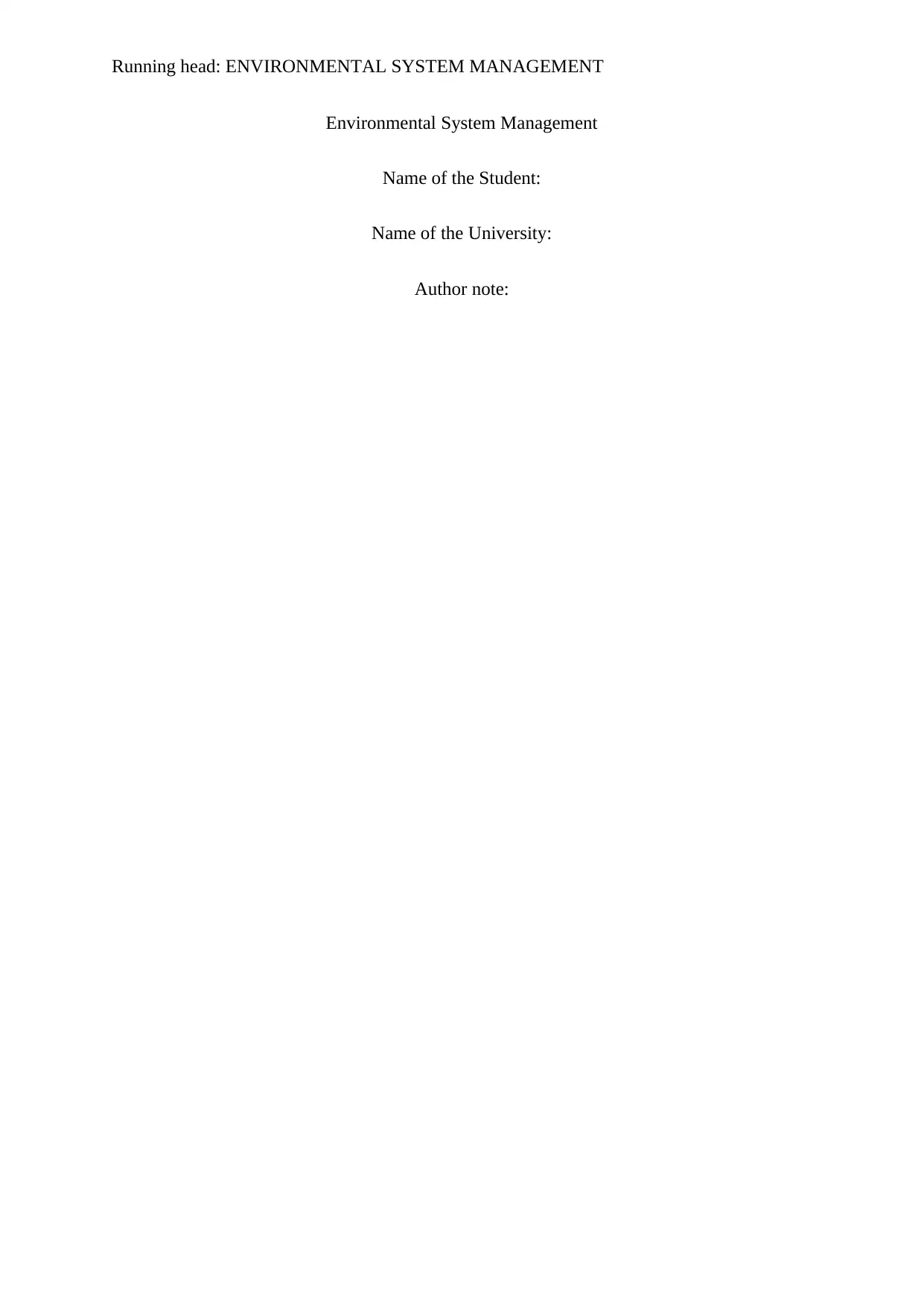
Running head: ENVIRONMENTAL SYSTEM MANAGEMENT
Environmental System Management
Name of the Student:
Name of the University:
Author note:
Environmental System Management
Name of the Student:
Name of the University:
Author note:
Paraphrase This Document
Need a fresh take? Get an instant paraphrase of this document with our AI Paraphraser
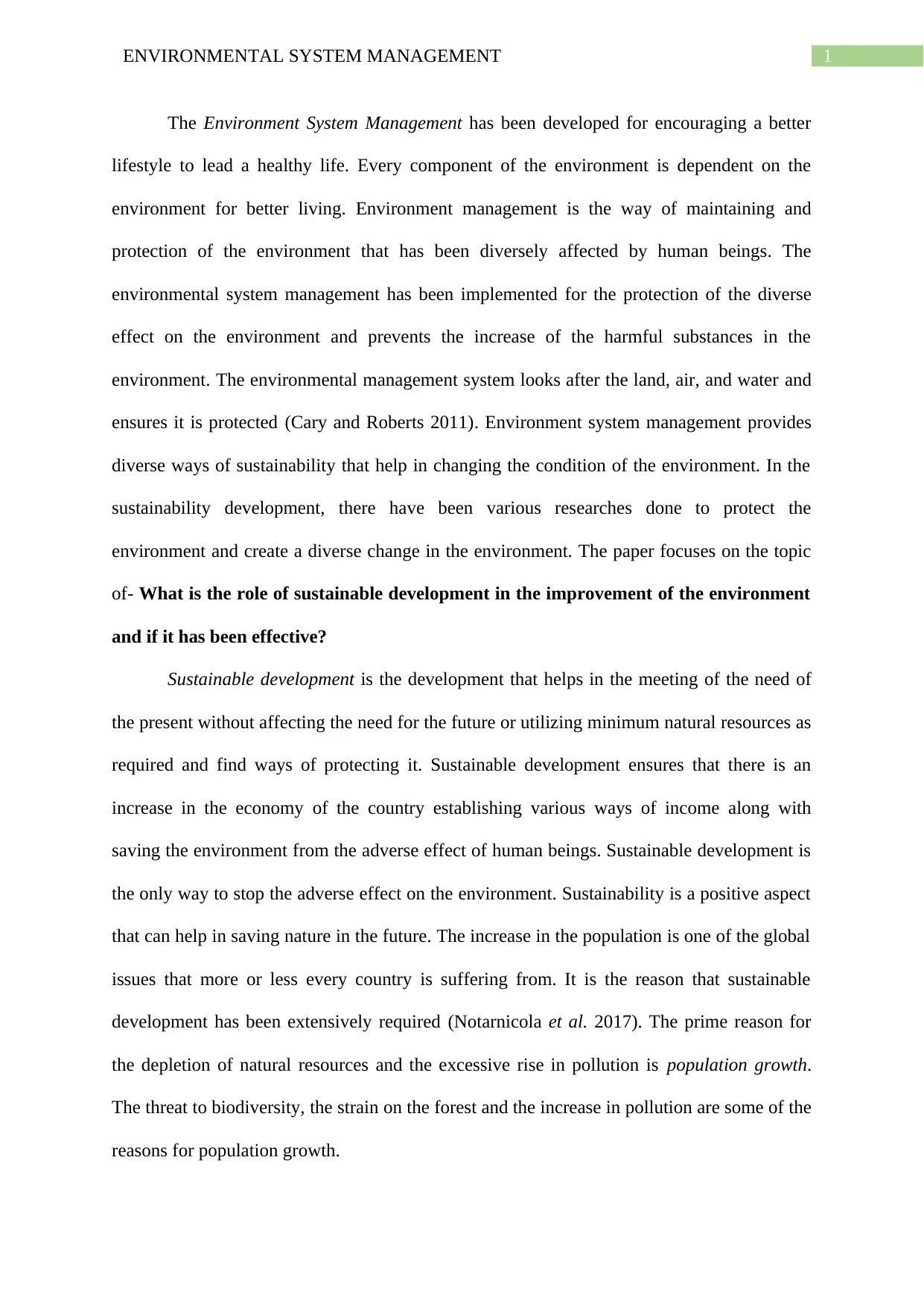
1ENVIRONMENTAL SYSTEM MANAGEMENT
The Environment System Management has been developed for encouraging a better
lifestyle to lead a healthy life. Every component of the environment is dependent on the
environment for better living. Environment management is the way of maintaining and
protection of the environment that has been diversely affected by human beings. The
environmental system management has been implemented for the protection of the diverse
effect on the environment and prevents the increase of the harmful substances in the
environment. The environmental management system looks after the land, air, and water and
ensures it is protected (Cary and Roberts 2011). Environment system management provides
diverse ways of sustainability that help in changing the condition of the environment. In the
sustainability development, there have been various researches done to protect the
environment and create a diverse change in the environment. The paper focuses on the topic
of- What is the role of sustainable development in the improvement of the environment
and if it has been effective?
Sustainable development is the development that helps in the meeting of the need of
the present without affecting the need for the future or utilizing minimum natural resources as
required and find ways of protecting it. Sustainable development ensures that there is an
increase in the economy of the country establishing various ways of income along with
saving the environment from the adverse effect of human beings. Sustainable development is
the only way to stop the adverse effect on the environment. Sustainability is a positive aspect
that can help in saving nature in the future. The increase in the population is one of the global
issues that more or less every country is suffering from. It is the reason that sustainable
development has been extensively required (Notarnicola et al. 2017). The prime reason for
the depletion of natural resources and the excessive rise in pollution is population growth.
The threat to biodiversity, the strain on the forest and the increase in pollution are some of the
reasons for population growth.
The Environment System Management has been developed for encouraging a better
lifestyle to lead a healthy life. Every component of the environment is dependent on the
environment for better living. Environment management is the way of maintaining and
protection of the environment that has been diversely affected by human beings. The
environmental system management has been implemented for the protection of the diverse
effect on the environment and prevents the increase of the harmful substances in the
environment. The environmental management system looks after the land, air, and water and
ensures it is protected (Cary and Roberts 2011). Environment system management provides
diverse ways of sustainability that help in changing the condition of the environment. In the
sustainability development, there have been various researches done to protect the
environment and create a diverse change in the environment. The paper focuses on the topic
of- What is the role of sustainable development in the improvement of the environment
and if it has been effective?
Sustainable development is the development that helps in the meeting of the need of
the present without affecting the need for the future or utilizing minimum natural resources as
required and find ways of protecting it. Sustainable development ensures that there is an
increase in the economy of the country establishing various ways of income along with
saving the environment from the adverse effect of human beings. Sustainable development is
the only way to stop the adverse effect on the environment. Sustainability is a positive aspect
that can help in saving nature in the future. The increase in the population is one of the global
issues that more or less every country is suffering from. It is the reason that sustainable
development has been extensively required (Notarnicola et al. 2017). The prime reason for
the depletion of natural resources and the excessive rise in pollution is population growth.
The threat to biodiversity, the strain on the forest and the increase in pollution are some of the
reasons for population growth.
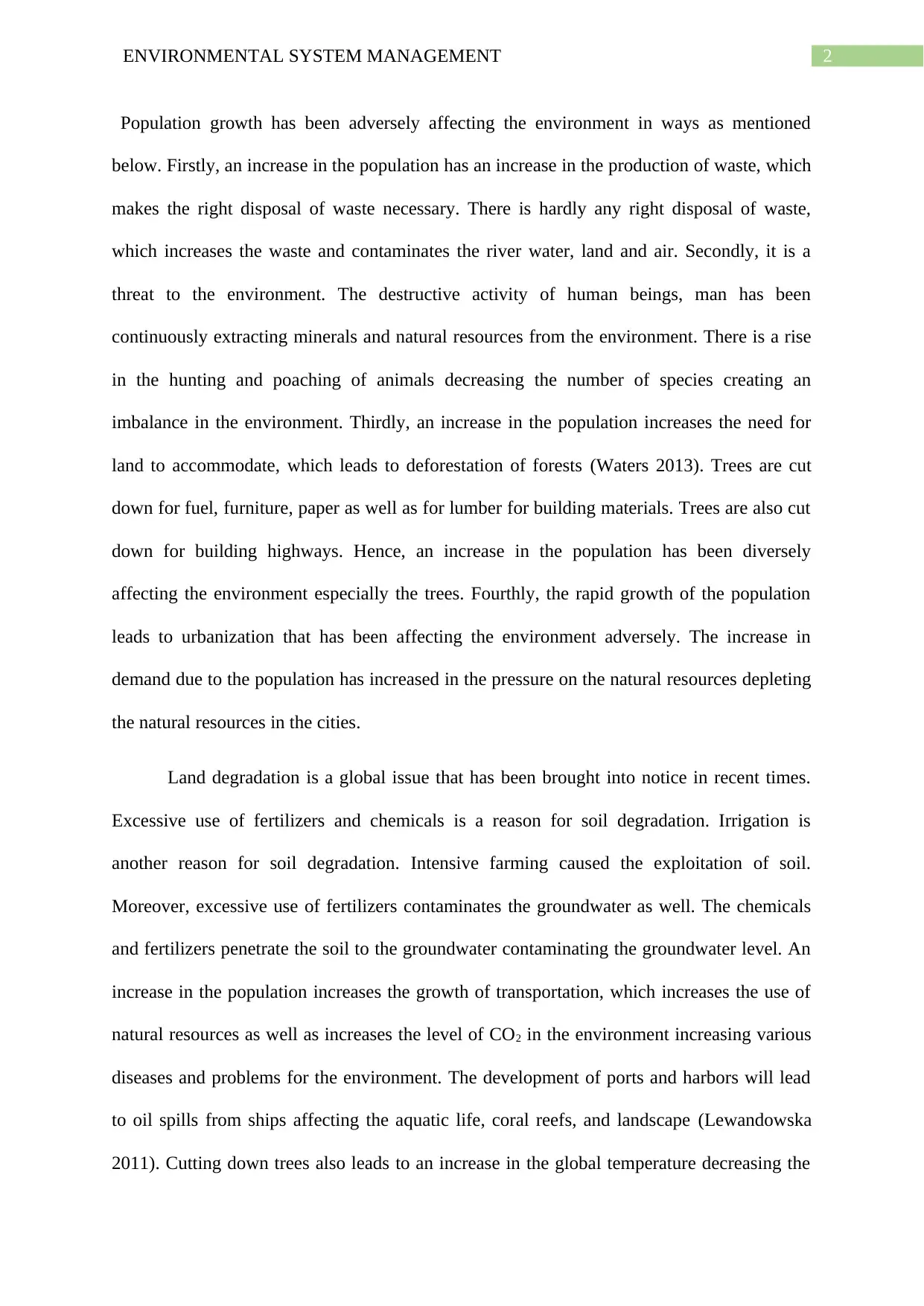
2ENVIRONMENTAL SYSTEM MANAGEMENT
Population growth has been adversely affecting the environment in ways as mentioned
below. Firstly, an increase in the population has an increase in the production of waste, which
makes the right disposal of waste necessary. There is hardly any right disposal of waste,
which increases the waste and contaminates the river water, land and air. Secondly, it is a
threat to the environment. The destructive activity of human beings, man has been
continuously extracting minerals and natural resources from the environment. There is a rise
in the hunting and poaching of animals decreasing the number of species creating an
imbalance in the environment. Thirdly, an increase in the population increases the need for
land to accommodate, which leads to deforestation of forests (Waters 2013). Trees are cut
down for fuel, furniture, paper as well as for lumber for building materials. Trees are also cut
down for building highways. Hence, an increase in the population has been diversely
affecting the environment especially the trees. Fourthly, the rapid growth of the population
leads to urbanization that has been affecting the environment adversely. The increase in
demand due to the population has increased in the pressure on the natural resources depleting
the natural resources in the cities.
Land degradation is a global issue that has been brought into notice in recent times.
Excessive use of fertilizers and chemicals is a reason for soil degradation. Irrigation is
another reason for soil degradation. Intensive farming caused the exploitation of soil.
Moreover, excessive use of fertilizers contaminates the groundwater as well. The chemicals
and fertilizers penetrate the soil to the groundwater contaminating the groundwater level. An
increase in the population increases the growth of transportation, which increases the use of
natural resources as well as increases the level of CO2 in the environment increasing various
diseases and problems for the environment. The development of ports and harbors will lead
to oil spills from ships affecting the aquatic life, coral reefs, and landscape (Lewandowska
2011). Cutting down trees also leads to an increase in the global temperature decreasing the
Population growth has been adversely affecting the environment in ways as mentioned
below. Firstly, an increase in the population has an increase in the production of waste, which
makes the right disposal of waste necessary. There is hardly any right disposal of waste,
which increases the waste and contaminates the river water, land and air. Secondly, it is a
threat to the environment. The destructive activity of human beings, man has been
continuously extracting minerals and natural resources from the environment. There is a rise
in the hunting and poaching of animals decreasing the number of species creating an
imbalance in the environment. Thirdly, an increase in the population increases the need for
land to accommodate, which leads to deforestation of forests (Waters 2013). Trees are cut
down for fuel, furniture, paper as well as for lumber for building materials. Trees are also cut
down for building highways. Hence, an increase in the population has been diversely
affecting the environment especially the trees. Fourthly, the rapid growth of the population
leads to urbanization that has been affecting the environment adversely. The increase in
demand due to the population has increased in the pressure on the natural resources depleting
the natural resources in the cities.
Land degradation is a global issue that has been brought into notice in recent times.
Excessive use of fertilizers and chemicals is a reason for soil degradation. Irrigation is
another reason for soil degradation. Intensive farming caused the exploitation of soil.
Moreover, excessive use of fertilizers contaminates the groundwater as well. The chemicals
and fertilizers penetrate the soil to the groundwater contaminating the groundwater level. An
increase in the population increases the growth of transportation, which increases the use of
natural resources as well as increases the level of CO2 in the environment increasing various
diseases and problems for the environment. The development of ports and harbors will lead
to oil spills from ships affecting the aquatic life, coral reefs, and landscape (Lewandowska
2011). Cutting down trees also leads to an increase in the global temperature decreasing the
⊘ This is a preview!⊘
Do you want full access?
Subscribe today to unlock all pages.

Trusted by 1+ million students worldwide
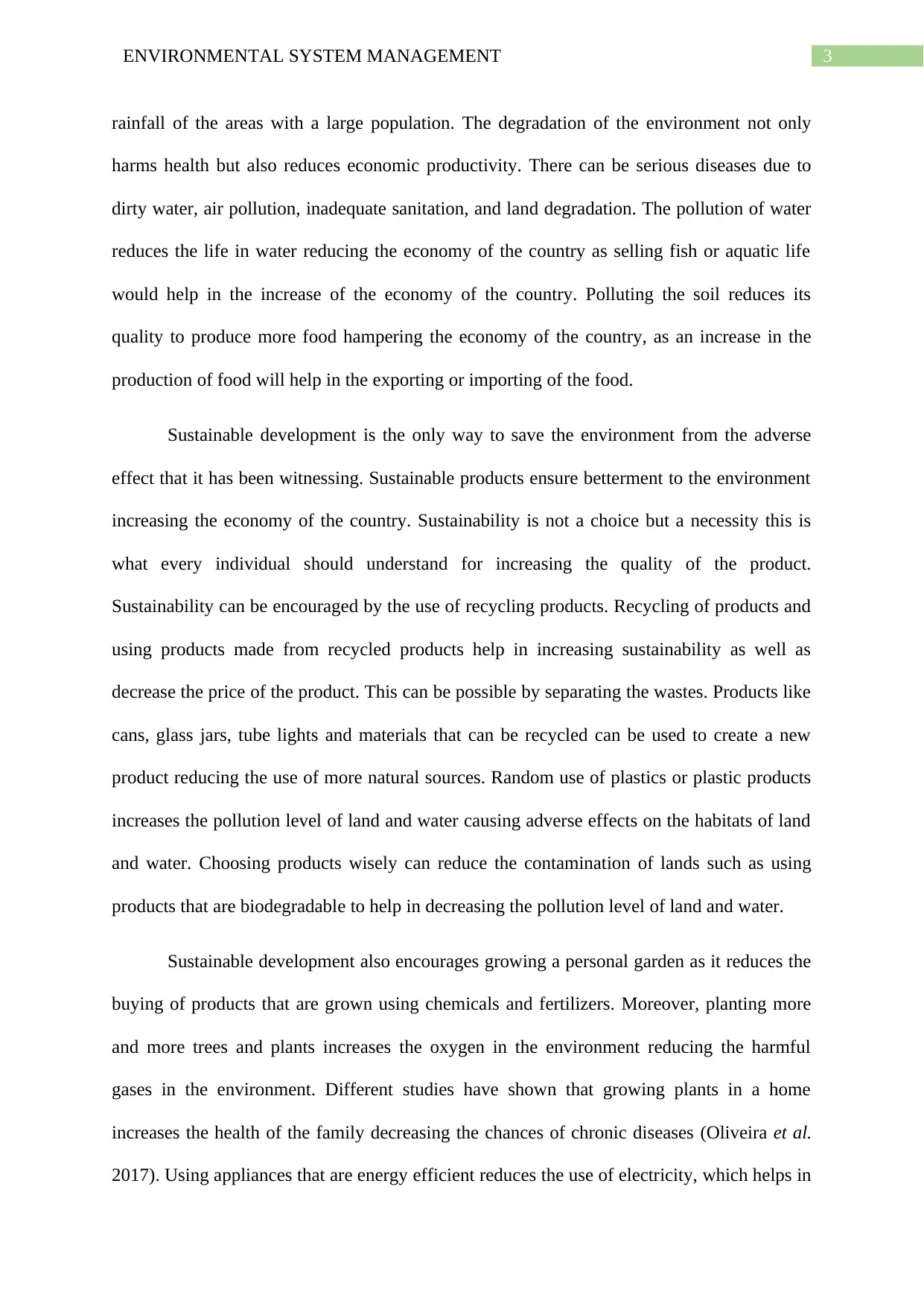
3ENVIRONMENTAL SYSTEM MANAGEMENT
rainfall of the areas with a large population. The degradation of the environment not only
harms health but also reduces economic productivity. There can be serious diseases due to
dirty water, air pollution, inadequate sanitation, and land degradation. The pollution of water
reduces the life in water reducing the economy of the country as selling fish or aquatic life
would help in the increase of the economy of the country. Polluting the soil reduces its
quality to produce more food hampering the economy of the country, as an increase in the
production of food will help in the exporting or importing of the food.
Sustainable development is the only way to save the environment from the adverse
effect that it has been witnessing. Sustainable products ensure betterment to the environment
increasing the economy of the country. Sustainability is not a choice but a necessity this is
what every individual should understand for increasing the quality of the product.
Sustainability can be encouraged by the use of recycling products. Recycling of products and
using products made from recycled products help in increasing sustainability as well as
decrease the price of the product. This can be possible by separating the wastes. Products like
cans, glass jars, tube lights and materials that can be recycled can be used to create a new
product reducing the use of more natural sources. Random use of plastics or plastic products
increases the pollution level of land and water causing adverse effects on the habitats of land
and water. Choosing products wisely can reduce the contamination of lands such as using
products that are biodegradable to help in decreasing the pollution level of land and water.
Sustainable development also encourages growing a personal garden as it reduces the
buying of products that are grown using chemicals and fertilizers. Moreover, planting more
and more trees and plants increases the oxygen in the environment reducing the harmful
gases in the environment. Different studies have shown that growing plants in a home
increases the health of the family decreasing the chances of chronic diseases (Oliveira et al.
2017). Using appliances that are energy efficient reduces the use of electricity, which helps in
rainfall of the areas with a large population. The degradation of the environment not only
harms health but also reduces economic productivity. There can be serious diseases due to
dirty water, air pollution, inadequate sanitation, and land degradation. The pollution of water
reduces the life in water reducing the economy of the country as selling fish or aquatic life
would help in the increase of the economy of the country. Polluting the soil reduces its
quality to produce more food hampering the economy of the country, as an increase in the
production of food will help in the exporting or importing of the food.
Sustainable development is the only way to save the environment from the adverse
effect that it has been witnessing. Sustainable products ensure betterment to the environment
increasing the economy of the country. Sustainability is not a choice but a necessity this is
what every individual should understand for increasing the quality of the product.
Sustainability can be encouraged by the use of recycling products. Recycling of products and
using products made from recycled products help in increasing sustainability as well as
decrease the price of the product. This can be possible by separating the wastes. Products like
cans, glass jars, tube lights and materials that can be recycled can be used to create a new
product reducing the use of more natural sources. Random use of plastics or plastic products
increases the pollution level of land and water causing adverse effects on the habitats of land
and water. Choosing products wisely can reduce the contamination of lands such as using
products that are biodegradable to help in decreasing the pollution level of land and water.
Sustainable development also encourages growing a personal garden as it reduces the
buying of products that are grown using chemicals and fertilizers. Moreover, planting more
and more trees and plants increases the oxygen in the environment reducing the harmful
gases in the environment. Different studies have shown that growing plants in a home
increases the health of the family decreasing the chances of chronic diseases (Oliveira et al.
2017). Using appliances that are energy efficient reduces the use of electricity, which helps in
Paraphrase This Document
Need a fresh take? Get an instant paraphrase of this document with our AI Paraphraser
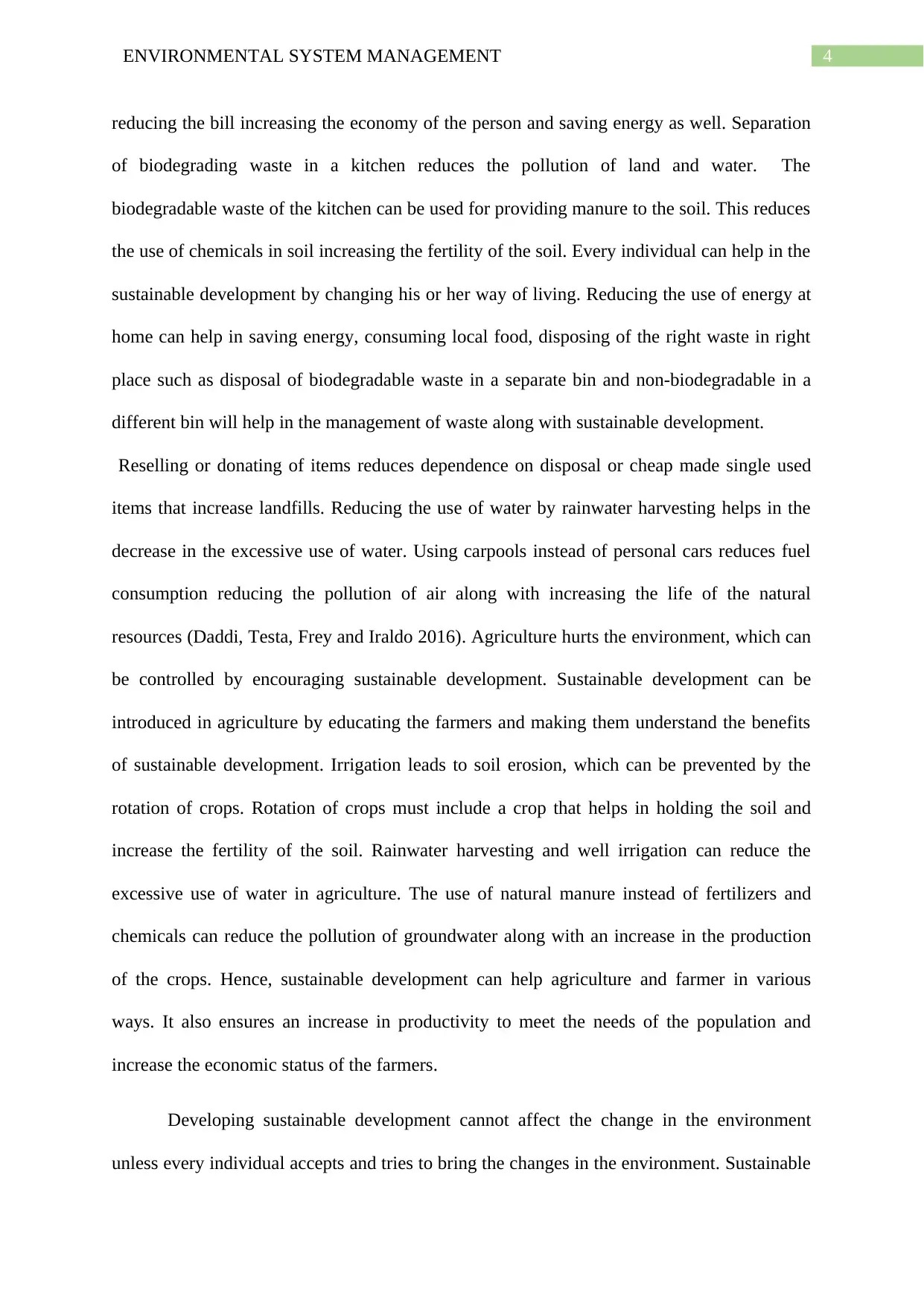
4ENVIRONMENTAL SYSTEM MANAGEMENT
reducing the bill increasing the economy of the person and saving energy as well. Separation
of biodegrading waste in a kitchen reduces the pollution of land and water. The
biodegradable waste of the kitchen can be used for providing manure to the soil. This reduces
the use of chemicals in soil increasing the fertility of the soil. Every individual can help in the
sustainable development by changing his or her way of living. Reducing the use of energy at
home can help in saving energy, consuming local food, disposing of the right waste in right
place such as disposal of biodegradable waste in a separate bin and non-biodegradable in a
different bin will help in the management of waste along with sustainable development.
Reselling or donating of items reduces dependence on disposal or cheap made single used
items that increase landfills. Reducing the use of water by rainwater harvesting helps in the
decrease in the excessive use of water. Using carpools instead of personal cars reduces fuel
consumption reducing the pollution of air along with increasing the life of the natural
resources (Daddi, Testa, Frey and Iraldo 2016). Agriculture hurts the environment, which can
be controlled by encouraging sustainable development. Sustainable development can be
introduced in agriculture by educating the farmers and making them understand the benefits
of sustainable development. Irrigation leads to soil erosion, which can be prevented by the
rotation of crops. Rotation of crops must include a crop that helps in holding the soil and
increase the fertility of the soil. Rainwater harvesting and well irrigation can reduce the
excessive use of water in agriculture. The use of natural manure instead of fertilizers and
chemicals can reduce the pollution of groundwater along with an increase in the production
of the crops. Hence, sustainable development can help agriculture and farmer in various
ways. It also ensures an increase in productivity to meet the needs of the population and
increase the economic status of the farmers.
Developing sustainable development cannot affect the change in the environment
unless every individual accepts and tries to bring the changes in the environment. Sustainable
reducing the bill increasing the economy of the person and saving energy as well. Separation
of biodegrading waste in a kitchen reduces the pollution of land and water. The
biodegradable waste of the kitchen can be used for providing manure to the soil. This reduces
the use of chemicals in soil increasing the fertility of the soil. Every individual can help in the
sustainable development by changing his or her way of living. Reducing the use of energy at
home can help in saving energy, consuming local food, disposing of the right waste in right
place such as disposal of biodegradable waste in a separate bin and non-biodegradable in a
different bin will help in the management of waste along with sustainable development.
Reselling or donating of items reduces dependence on disposal or cheap made single used
items that increase landfills. Reducing the use of water by rainwater harvesting helps in the
decrease in the excessive use of water. Using carpools instead of personal cars reduces fuel
consumption reducing the pollution of air along with increasing the life of the natural
resources (Daddi, Testa, Frey and Iraldo 2016). Agriculture hurts the environment, which can
be controlled by encouraging sustainable development. Sustainable development can be
introduced in agriculture by educating the farmers and making them understand the benefits
of sustainable development. Irrigation leads to soil erosion, which can be prevented by the
rotation of crops. Rotation of crops must include a crop that helps in holding the soil and
increase the fertility of the soil. Rainwater harvesting and well irrigation can reduce the
excessive use of water in agriculture. The use of natural manure instead of fertilizers and
chemicals can reduce the pollution of groundwater along with an increase in the production
of the crops. Hence, sustainable development can help agriculture and farmer in various
ways. It also ensures an increase in productivity to meet the needs of the population and
increase the economic status of the farmers.
Developing sustainable development cannot affect the change in the environment
unless every individual accepts and tries to bring the changes in the environment. Sustainable
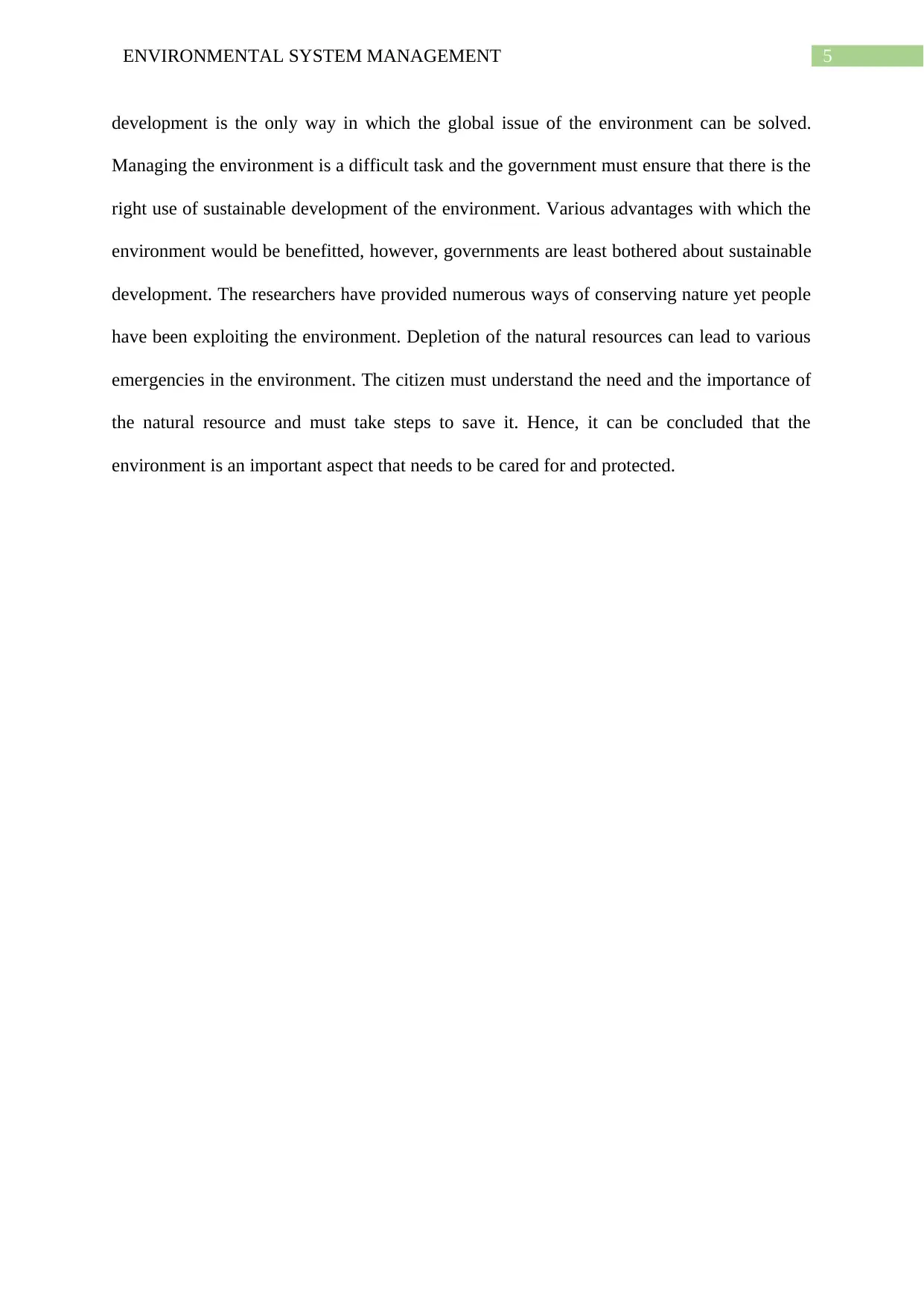
5ENVIRONMENTAL SYSTEM MANAGEMENT
development is the only way in which the global issue of the environment can be solved.
Managing the environment is a difficult task and the government must ensure that there is the
right use of sustainable development of the environment. Various advantages with which the
environment would be benefitted, however, governments are least bothered about sustainable
development. The researchers have provided numerous ways of conserving nature yet people
have been exploiting the environment. Depletion of the natural resources can lead to various
emergencies in the environment. The citizen must understand the need and the importance of
the natural resource and must take steps to save it. Hence, it can be concluded that the
environment is an important aspect that needs to be cared for and protected.
development is the only way in which the global issue of the environment can be solved.
Managing the environment is a difficult task and the government must ensure that there is the
right use of sustainable development of the environment. Various advantages with which the
environment would be benefitted, however, governments are least bothered about sustainable
development. The researchers have provided numerous ways of conserving nature yet people
have been exploiting the environment. Depletion of the natural resources can lead to various
emergencies in the environment. The citizen must understand the need and the importance of
the natural resource and must take steps to save it. Hence, it can be concluded that the
environment is an important aspect that needs to be cared for and protected.
⊘ This is a preview!⊘
Do you want full access?
Subscribe today to unlock all pages.

Trusted by 1+ million students worldwide
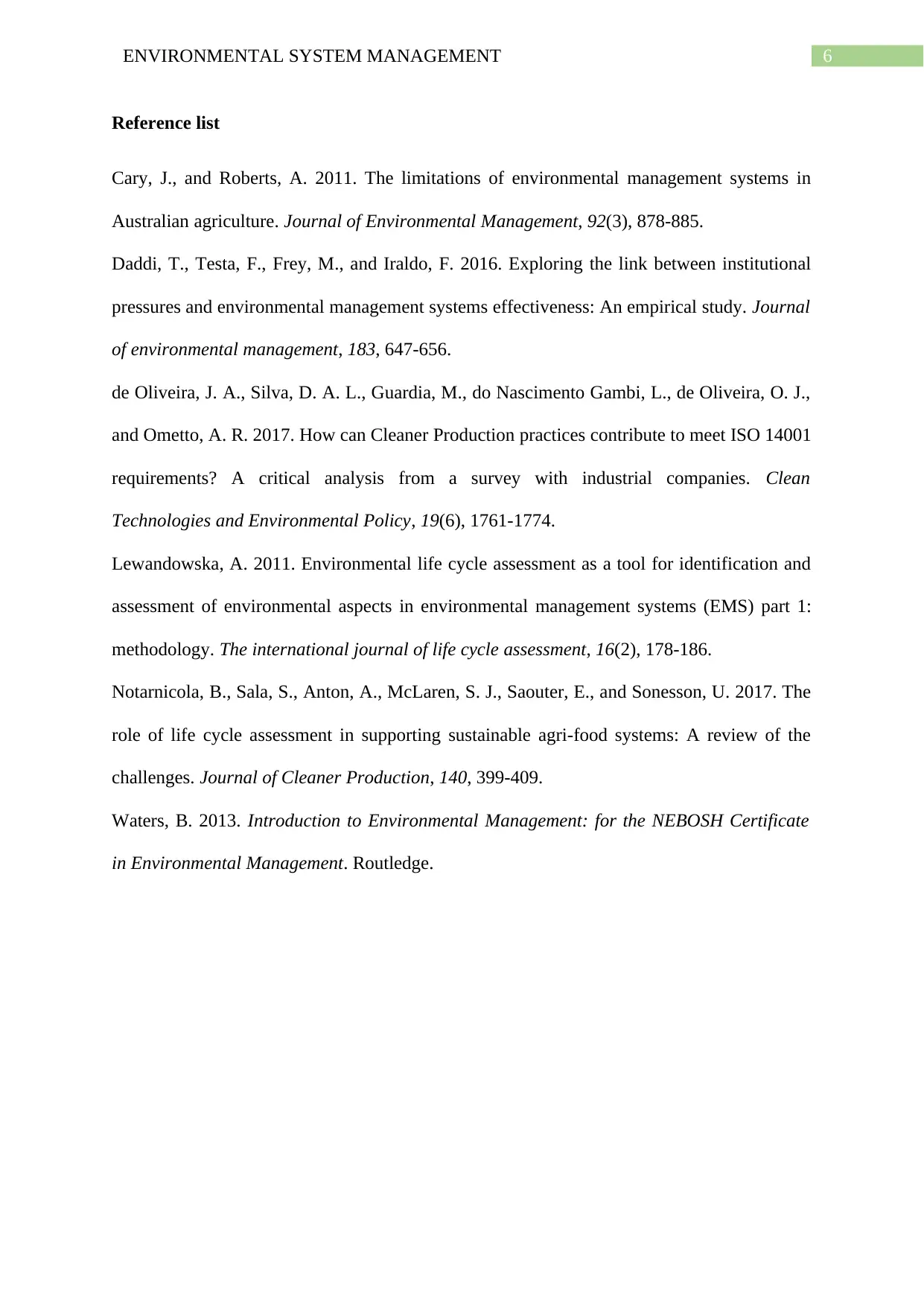
6ENVIRONMENTAL SYSTEM MANAGEMENT
Reference list
Cary, J., and Roberts, A. 2011. The limitations of environmental management systems in
Australian agriculture. Journal of Environmental Management, 92(3), 878-885.
Daddi, T., Testa, F., Frey, M., and Iraldo, F. 2016. Exploring the link between institutional
pressures and environmental management systems effectiveness: An empirical study. Journal
of environmental management, 183, 647-656.
de Oliveira, J. A., Silva, D. A. L., Guardia, M., do Nascimento Gambi, L., de Oliveira, O. J.,
and Ometto, A. R. 2017. How can Cleaner Production practices contribute to meet ISO 14001
requirements? A critical analysis from a survey with industrial companies. Clean
Technologies and Environmental Policy, 19(6), 1761-1774.
Lewandowska, A. 2011. Environmental life cycle assessment as a tool for identification and
assessment of environmental aspects in environmental management systems (EMS) part 1:
methodology. The international journal of life cycle assessment, 16(2), 178-186.
Notarnicola, B., Sala, S., Anton, A., McLaren, S. J., Saouter, E., and Sonesson, U. 2017. The
role of life cycle assessment in supporting sustainable agri-food systems: A review of the
challenges. Journal of Cleaner Production, 140, 399-409.
Waters, B. 2013. Introduction to Environmental Management: for the NEBOSH Certificate
in Environmental Management. Routledge.
Reference list
Cary, J., and Roberts, A. 2011. The limitations of environmental management systems in
Australian agriculture. Journal of Environmental Management, 92(3), 878-885.
Daddi, T., Testa, F., Frey, M., and Iraldo, F. 2016. Exploring the link between institutional
pressures and environmental management systems effectiveness: An empirical study. Journal
of environmental management, 183, 647-656.
de Oliveira, J. A., Silva, D. A. L., Guardia, M., do Nascimento Gambi, L., de Oliveira, O. J.,
and Ometto, A. R. 2017. How can Cleaner Production practices contribute to meet ISO 14001
requirements? A critical analysis from a survey with industrial companies. Clean
Technologies and Environmental Policy, 19(6), 1761-1774.
Lewandowska, A. 2011. Environmental life cycle assessment as a tool for identification and
assessment of environmental aspects in environmental management systems (EMS) part 1:
methodology. The international journal of life cycle assessment, 16(2), 178-186.
Notarnicola, B., Sala, S., Anton, A., McLaren, S. J., Saouter, E., and Sonesson, U. 2017. The
role of life cycle assessment in supporting sustainable agri-food systems: A review of the
challenges. Journal of Cleaner Production, 140, 399-409.
Waters, B. 2013. Introduction to Environmental Management: for the NEBOSH Certificate
in Environmental Management. Routledge.
1 out of 7
Related Documents
Your All-in-One AI-Powered Toolkit for Academic Success.
+13062052269
info@desklib.com
Available 24*7 on WhatsApp / Email
![[object Object]](/_next/static/media/star-bottom.7253800d.svg)
Unlock your academic potential
Copyright © 2020–2025 A2Z Services. All Rights Reserved. Developed and managed by ZUCOL.





